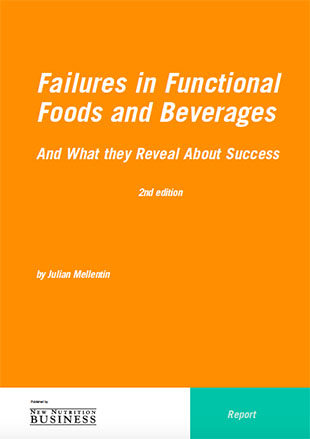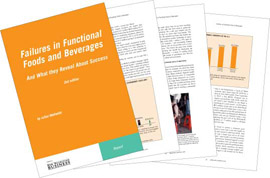Price (PDF or PPT):
US$530 £320 €400 NZ$630 AU$570 ¥550000
20% Discount if PDF and PPT purchased together

The functional foods market is a complex one. Success with a new product or ingredient is rare. This unique 98-page report examines failures by functional brands and ingredients. It sets out the lessons that can be applied by anyone trying to develop an effective strategy for a brand or trying to commercialise nutrition science and offers concise strategies for reducing the risk of failure.
About this report
The functional foods market is a tough one. Success with a new product or ingredient in this harsh and demanding market is very rare. In fact, failure is far more common than success and most products sell on a niche basis with very few ever graduating into the mass market.
This unique 98-page report examines brands and ingredients that have either been withdrawn from market or have not performed as well as expected. It sets out the lessons that can be applied by anyone trying to develop an effective strategy for a brand or trying to commercialise nutrition science.
The categories covered in this report are:
- Dairy drinks and yoghurts
- Breakfast cereals
- Water
- Juice drinks
- Soy drinks
The health benefit platforms covered include:
- Weight management (satiety and calorie-burning)
- Heart health (cholesterol-lowering, blood pressure-lowering)
- Bone health
- Joint health
- Beauty and skin
- Energy
- Digestive health
- Brain and eye development
Ingredients featured include:
- Probiotics
- Prebiotics
- Fibre
- Wholegrains
- Plant sterols and stanols
- Green tea
- Omega-3
- CoEnzyme Q10
- Protein
- Soy
- Calcium
- Glucosamine
- Antioxidants
The report is in two parts. Part I is a concise 40-page analysis setting out:
- Which brand strategies are most effective and why
- Which ingredient strategies are most effective and why
Part II consists of 15 detailed case studies which summarise:
- success factors, and common causes of failure
- common lessons for pricing, positioning and marketing
- key lessons in selecting ingredients
- key lessons in communicating benefits
- how to extend an existing brand
- how to create a successful new brand
Each case study is based on interviews with executives at the companies concerned. They speak with considerable frankness about challenges they have encountered. We have set their opinions in the context of our own analysis – which means that we do not always agree with some companies’ self-analysis – to create a template that will be useful to anyone trying to develop a new product with health benefits or devise a strategy in health.


